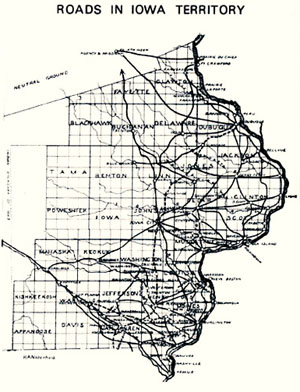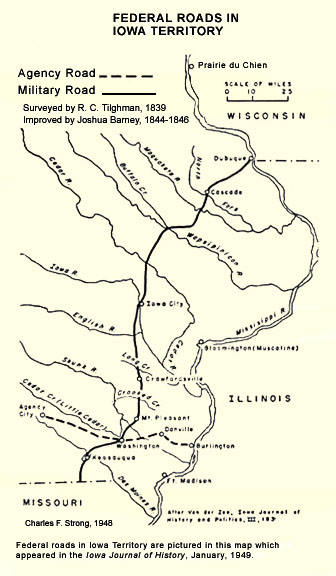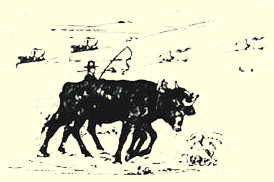|
TEAMSTERS GUIDE TO IOWA |
||||
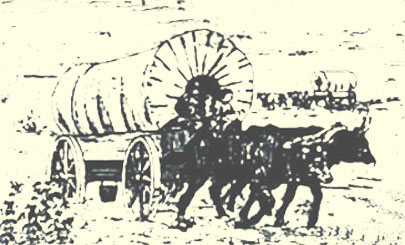 |
||||
|
|
||||
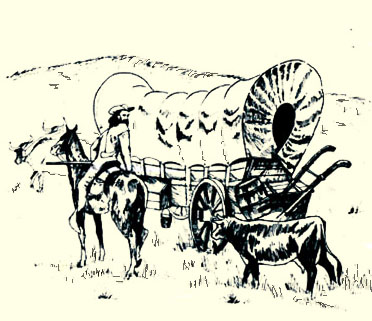 |
||||
| BEST TIME TO MOVE WEST | ||||
|
Fall is the best time to move West by wagon. Roads are in top condition from September through November. There is little rain in the Ohio and Mississippi River valleys in the autumn. The roads and many of the smaller streams become dry. Most of the rivers are easily forded because the water level is very low. In the Fall, the emigrant enjoys mild weather. Heavy rains in the Spring result in muddy roads. Swollen rivers are hard for teams and wagons to cross. Flood plains and sloughs may trick even the best teamsters. Both the summer and winter are unbearable. The heat of mid‑summer causes fatigue and illness. During the winter wagons can be caught in the severe snow storms of the prairie. By waiting until Fall, the farmer planning a move West can harvest one more crop. The sale of the grain gives him additional travel money. He can take his own surplus produce with him. Farmers along the way are more anxious to sell their produce. There is less danger of a shortage of rations for the trip. If the family is to remain behind with relatives, the sale of the crop provides them with needed cash. |
||||
| YOUR WAGON | ||||
|
The Iowa bound emigrant has a great choice of wagons. Most ten to fifteen foot farm wagons are suitable for the trip to Iowa. It is easy to cover the average farm wagon. A frame can be made by fastening five or six hickory boughs to the sides. A canvas cover, or cloth treated with linseed oil, can be tied to the hickory frame. The front end has flaps back of the driver's seat. The rear is closed with a "puckering" string. The typical Conestoga wagon is longer. It may measure from fifteen to twenty feet. It is 4'/2 feet in width. The sides are flared, with both the front and rear ends higher than the center section. It is heavier and thus permits a heavier cargo. However, it is necessary to have an additional team of horses or a yoke of oxen. |
||||
|
|
||||
|
Most wagons are made of hardwood. Some wagonmakers soak and boil the axles in oil. This process drives out excess moisture and adds toughness to the wood. Wagon wood needs to be well‑seasoned by letting it dry from three to five years. Iron tires around the wheels make for smoother rides. The average wagon is priced from $300 to $1000, dependent upon circumstances and place of delivery. Prices for wagons rise on the western frontier. Thus, it is a good idea to move to Iowa in a wagon which can be used in farm operations. |
||||
|
HORSES OR OXEN |
||||
|
There seems to be as many arguments for horses or oxen as animal power as there are people on the frontier. Both kinds have their good points and their bad points. Oxen are slower, easier to control than horses, and can pull greater weights. They can endure long, hard work. After reaching Iowa, the oxen can be used to pull breaking plows. In case of real need, oxen can be butchered and eaten as any other beef. They also cost less than horses, with typical price of $25 each compared to horses of from $75 to $150. Horses are faster than oxen. They can be used in a variety of ways. They are good for scouting the route ahead. Horses are needed to send to farms or towns for help. However, they cannot pull heavy loads for a long period of time. They need to be fed grain which has to be carried in the wagon. They are more likely to be stampeded than oxen. Horses are more likely to be stolen than oxen. The Iowa bound farmer will probably use the draft animals which are easiest to obtain. If a choice can be made, the editors of this guide recommend four oxen and one horse as a minimum. However, the wise farmer will take additional draft animals to Iowa. |
||||
|
|
||||
|
GETTING LOADED |
||||
|
The wagon serves two purposes‑it is a freight wagon and also the emigrant's home. Its size determines how much can be moved to the west. Its use as a shelter depends on how the wagon is loaded. Many western emigrants use their present farm wagons. Others will build new wagons. A good teamster will be able to load 2 to 4 thousand pounds in an average farm wagon. Some heavy Conestogas can carry 4‑6 tons. The secret of efficient loading lies in compact packing. Some teamsters add to the cargo by making a second bottom for the wagon. This second bottom may be as much as two feet deep. Goods which are not needed during the trip may be stored in the false bottom. This system permits easier access to things used on the journey. A smooth running wagon has its weight evenly distributed. Too much cargo on one side, or at one end, causes the wagon to be top heavy. I n such a case, the wheels on one side, or at one end, cut a deeper rut. This results in a harder pull for either oxen or horses. The wise packer will load items not needed during the trip first. Valuables should be packed so that strangers are not sure of their location in the wagon. The boxes on the side of the wagons are intended for a spare axle, axle grease, a shovel, an axe, and food. Some emigrants will set a cook stove near the rear end. This permits the cooking of regular meals. With a large wagon, it is possible to leave some free floor space. The extra floor space can be used for sleeping purposes. |
||||
|
|
||||
|
BURLINGTON FERRY |
||||
|
The new, large and safe Steam Boat SHOCKOQUON, Is now running regularly between Burlington, Iowa, and the Illinois shore, every few minutes during the day. The SHOCKOQUON has no competitor on the Upper Mississippi, as to safety, convenience and extensive accommodations; is staunch built, and in perfect order in every respect. Travellers on their way to Iowa Territory, will find it in their interest to cross the river at Burlington.
Persons crossing to Burlington
for the purpose of bringing Produce and Marketing and returning the same
day, will only be charged one Fare, or HALF PRICE. |
||||
|
||||
|
|
||||
|
FOOD |
||||
|
Each emigrant family will choose their own supply of food. Much of their choice depends on those foods easy to obtain. It is a good idea to bring as much food as possible. The traveller may reach Iowa's river ports at a time when prices begin to go up. Price increases can result from a poor crop or slow trade on the river. This guide suggests certain foods which can be safely carried in a wagon. They are also easy to keep during the winter after one arrives in Iowa. Supplies should be put up in the most secure, compact, and portable shape. Bacon should be packed in strong sacks. Cured pork may be packed in sacks, like bacon. If placed in the bottom of the wagon it will keep cool. Flour should be sacked in well sewed burlap, a hundred pounds in each sack. Sugar may be secured in glass bottles or a metal container. Cheese of all kinds may be packed in cooler parts of the wagon. Dried fruits and vegetables, like beans, are easily carried in sacks. With corn meal, beans may form the chief‑item in the frontier meal. Most emigrant families bring their own milk cow. Thus, the travellers have a steady supply of healthful milk. This is a checklist of food supplies which can be taken on a western trip: |
||||
|
||||
|
The emigrant will find the farm families along the route to be very friendly. Most welcome overnight stops by those passing through. This gives western farmers a chance to catch up on news from the East. Some will even accompany the emigrant for a few days beyond their homes. On reaching the Mississippi River, it may be necessary to stop a day or two. If there is a large backlog of wagons for the ferries, a family may have to wait their turn. At times the ferries do not operate more than once a day. Some ferry captains will not run on Sunday. After crossing the Mississippi, it is a good idea to camp out for a day or two. Iowa's great cities, like Keokuk, Fort Madison, Burlington, Muscatine, Davenport, and Dubuque, boast reputable outfitters. A stop of several days gives the Western bound farmer a chance to check his tools and supplies. One may want to purchase additional supplies before moving to the interior. |
||||
|
|
||||
|
HAZARDOUS SLOUGHS |
||||
|
A bad slough can wreck your
wagon. It is easy to mire down in one after a rainy season. Sometimes a
muddy area is hidden by
tall grass First of all, one should not try to drive a team out of the mud with a fully loaded wagon. It will only mire down deeper. It is a good idea for the men and boys to strip naked. They can take off their clothes in the wagon. Then they should carry the women and children to the safety of dry land. Next the wagon should be unloaded until it can be moved through the mud. Once the load is lightened, it is possible the team may be able to pull the wagon out. If near timber, it may be necessary to cut a fence rail out of a tree. The wagon might be moved by placing the timber under the rear axle at a 450 angle. Then it requires pure muscle to move the wagon only a few inches at a time. Some unfortunate teamsters have had to take their wagons apart and rebuild them on dryland. |
||||
|
|
||||
|
PLANK ROADS |
||||
|
The attention of the people in this region is now turned to the construction of Plank Roads. The experiment has been fully tested and their utility demonstrated. The Farmers, who receive immediate benefit from the facilities of getting to market by such means, can of themselves easily devise and construct them. The numbers already and now being laid in New York, Wisconsin and Illinois, show that they pay well. Four horses, on one of the plank roads leading from Utica, N.Y. haul a car of forty persons with more ease and speed, than they can a nine passenger coach pull over a common road. So is hauling produce, much larger leads can be taken to market, with less team. In whatever light it may be viewed the Plank roads offer facilities to the farmer, which cannot be secured by either Mcadamized roads or rail roads. All would prefer to pay a small toll for the privilege to carry their produce on a dry plank road‑especially when the common roads are bad‑than to occupy twice the time besides worrying out their teams on a common road for nothing. We have no doubt that the steps already taken by our own and the citizens of Mt. Pleasant will eventuate in the construction of a road of this kind between the two places, which will no doubt be extended to Fairfield and Washington. The most fraternal feeling exists between the citizens of this place and Mount Pleasant and such an improvement would only lead to increase this desirable feeling.. Our correspondent "F," who has been conversant with the utility of Plank Roads from their commencement in this country, has given information which must be of great value to all who may wish to inform themselves on this subject. We think, however, that he has made a very liberal estimate and that a road between this place and Mount Pleasant can be constructed within his estimate. Burlington Hawk‑Eye, January 11, 1849, p. 2. |
||||
|
|
||||
|
COME TO BURLINGTON |
||||
|
Burlington boasts an extensive network of plank roads to the West. Near completion is the road to Mt. Pleasant. Twenty miles is already in service. Future road plans include plank roads to Ft. Madison, Farmington, Washington, and Columbus - to all parts of the West. Plank roads assure the farmer of a steady supply of goods and a safe way to ship his produce to market at harvest time. Plank roads add to the safety and convenience of the traveller. Take advantage of the wisdom displayed by the enterprising Burlington merchants. |
||||
|
|
||||
|
IOWA'S ROAD SYSTEM |
||||
|
The Iowa‑bound farmer, merchant, or teamster will find one of the best road networks claimed by any State of the Union. As shown by the maps on pages and 10 of this guide, Iowans have long devoted their energies and resources to building a first‑rate road system. Using to their advantage the early Indian tracts, Iowans have identified the best routes of travel from the interior to each of Iowa's great rivers.
The Iowa Territorial and State
Legislatures, with the U.S. Congress, have left no stone unturned to build
t
Never ceasing in their efforts
to build better transportation systems, the people of Iowa are rapidly
adopting plank roads. The city of Burlingto A good road is essential to a prosperous State and Nation. Only through good roads are farmers able to sell their produce at favorable market times. Merchants need dependable transportation arteries to ship their goods. The U.S. Army requires good roads in defending the nation from aggressive enemies. Certainly anyone who has travelled extensively will appreciate the need for an adequate road network. The western bound emigrant will find that Iowa offers the very best. |
||||
|
BLACKSMITHS' PRICES DUBUQUE, DEC. 13, 1836. |
||||
|
We, the undersigned,
Blacksmiths of Dubuque, W.T., agree to establish and adhere to the
following prices, under the penalty of twenty‑five dollars for each and
every violation, and offer, as our reasons for raising our prices- |
||||
|
||||
|
|
||||
|
|
||||
|
GOOD FURNITURE AND CLOTHING |
||||
|
Every emigrant family has good furniture and clothing that they want to remove to the west. No one wants to leave their prized possessions in the East or in Europe to strangers, even to relatives. There is only so much room in a wagon. Space may not permit the taking of good beds and dressers or a dining room table and chairs. Some sideboards occupy too much space. A piano or organ may prove too bulky. All of a family's clothing may require two or three trunks. Shipping services to Iowa have improved in the past ten years. Both wagon freight companies and steamboats offer regular schedules from points East to Iowa. The shipping charges are reasonable. Most steamship companies charge from 50 to 65 cents per hundred from Boston, New York, Philadelphia to New Orleans. The price of freight from New Orleans to St. Louis is about 62'/2 cents per hundred. From St. Louis to Keokuk, freight charges range from 10 to 15 cents per hundred. Overland wagon trains charge more than steamboat companies. North of the Ohio River, wagonmasters charge an average of 1 to 1'/z cents per pound‑or $1 to $1 .50 per hundred pounds for a hundred miles. Atypical charge from Columbus, Ohio to Davenport, Iowa ranges from $5.50 to $9.00 per hundred weight. Ferry charges across the Mississippi are added to the freight bill. Boxes should be marked to the owner or his agent at the river port. Shipments by way of New Orleans should be marked to an agent in New Orleans, then St. Louis, and at the desired Iowa port. The West is served by a great number of reliable agents and merchants. Most charge reasonable storage rates if the emigrant cannot claim his property on its arrival. |
||||
|
|
||||
|
MACHINERY AND TOOLS |
||||
|
The Iowa bound farmer should move as much of his own machinery and as many tools as possible. Regardless of the season, the farmer will want to begin work upon arrival in Iowa. As soon as a claim is staked out, tools will be needed. A shelter and shed will have to be built. Land will have to be cleared of timber and rocks. Farm equipment should be repaired before planting crops. Outfitters in Iowa's major cities carry full lines of machinery and tools, but prices are high. The emigrant can save money by bringing machines and tools from his home. This list contains items needed to start farming in Iowa |
||||
|
||||
|
|
||||
|
CLOTHING |
||||
|
The Western emigrant will want only the roughest clothing for the trip. Good clothing should be packed in trunks. Proper clothing is of great importance for health and comfort. Cotton or linen fabrics do' not protect the body against the direct rays of the sun nor against rain. Wool, a nonconductor, is the best material for prairie travelling. The coat should be short and tight. Loose coats often are snagged on nails or bolts. Sometimes a snagged coat can lead to injury. The shirt should be of red or blue flannel. These can be found in all shops on the frontier. In warm weather, a flannel shirt serves as an outside garment. There is no place on the journey for a linen shirt. The pants should be of thick but soft woolen material. It is well to have them re‑enforced on the inside with soft buckskin, especially where they come in contact with the saddle. Woolen socks and stout boots, coming up to the knees, are recommended. The boots should be loose enough at the top to permit the pants to be tucked in. This will reduce the chances of snagging the pants. The knee‑high boots provide protection against snake‑bite. Frontiersmen are finding tight pants to serve them better than loose ones. Women will want to pack their good clothing. Only the coarsest articles should be worn on the trip to Iowa. Calico dresses are best suited to walking beside the wagon. Sun bonnets protect the face from the midday sun plus providing cover for the hair. High shoes or boots should be worn. They will help protect one from snake bite and also the early morning dew. Women will find shawls to be comfortable on chilly days. Wool coats are a necessity for Fall travel. The children's clothing, like the adults, should be sturdy quality. Their good clothes should be packed until the new home in Iowa is reached. The boy's clothes may be similar to their father's. If the sons do not have high boots, it would be a good idea to buy each a pair before leaving for Iowa. Naturally, girls will want to dress like their mothers. They, too, should have high shoes or boots. Children need at least one change of clothes on the trip. The Iowa bound emigrant will find a wealth of native materials with with which to replenish his and his family's wardrobe. Iowa is rich in game animals ‑ fox, raccoon, otter, beaver, rabbit, muskrat ‑ which will supply the finest of pelts to use in making coats, jackets, caps, mufflers as well as rugs and blankets. The hides of deer, buffalo, cattle, and hogs can be used in making pants, jackets, shoes, moccasins, and boots. Both hides and pelts may be shipped to St. Louis and New Orleans as a cash crop. Iowa's prairie lands are well‑suited to the grazing of sheep. Farmers in this area continuously report a bountiful supply of wool. Once the sod is broken, this beautiful cropland produces an abundance of all crops but the growing of flax is especially well‑known. |
||||
|
||||
|
BLOOMINGTON FERRY |
||||
|
The public are informed that the Ferry across the Mississippi River, at Bloomington, Iowa Territory, has been established, and as soon as the river is free from ice next spring a Boat will be in operation. In order to have access to the River opposite Bloomington, a large Flat Boat will be in the Slough with ropes to propel it, so that travellers coming to the Slough can ferry themselves, their wagons and stock across, without difficulty. The rates of ferrage will be as follows, viz: |
||||
|
||||
|
CHAS. A.
WARFIELD. |
||||
| Bloomington, Dec. 14, 1840‑tf. NB. When the water is high the Boat will run to Drury's Landing. |
||||
|
|
||||
|
SPEED |
||||
|
A good teamster can drive a fully loaded wagon 20 miles in a 12 hour day. Some exceed the 20 miles, but that distance is recommended for the emigrant. There will be days when only a few miles will be covered. Experienced teamsters have worked out a daily driving schedule. The emigrant will make real progress by following their advice. At dawn start the day's trip. Drive for one to two miles; then stop to allow animals to "breathe and urinate." Continue the trip by driving from seven to ten miles or till about ten o'clock. Unyoke the stock for two hours of grazing. At this time cook breakfast. Resume the trip for a second seven to ten miles. Camp again for three to four hours. At this time, allow the animals to graze and prepare supper. Then finish the day by driving another mile or two, until dark. Misfortunes will slow progress. Inclement weather may keep travellers at the same spot for a day or two. Wagons in need of repair results in lost time. Poor roads will reduce speed. Swollen streams make it difficult to cross rivers. Illness prevents travellers from reaching their destination. Short supplies of food results in delays while trying to buy food along the route. The western emigrant will want to make as much progress each day as possible. Twenty miles seems to be the greatest distance which can be covered in a day. Those travelling west by themselves or with one or two friends have some choice on where to stop. Those travelling in a train should follow the decisions of the wagonmaster. |
||||
|
|
||||
|
Stephenson and Davenport |
||||
|
The subscriber respectfully informs the travelling public, that he is well supplied with good crafts, and attentive hands at his ferry. That he has made arrangements with the ferry on Rock river, at the mouth of Green river, whereby persons wishing to cross at both ferries, with teams or on horseback, will be charged with ferriage across the Mississippi alone. He has on the stocks and will soon be ready for use, a Steam Ferry Boat, to ply between Stephenson and Davenport. Travellers from Chicago, Peoria, or any other point at the south or east, will find it their interest to pass by this route, on their way to the fertile valleys of Pine, Cedar, Iowa, Wabesipineca, or, indeed, any other part of the territory. It is the most direct route to Dubuque or even to Galena, as it cuts off a great bend in the river, and the traveller passes over a direct, dry and level road. Be not therefore diverted from this route by the idle tales of interested speculators.
Being furnished with two good
Ferry Flats, besides several small Boats, always in readiness to
accomodate the public‑ he hopes by industry and perseverance to merit and
receive the patronage of travellers and emigrants. Stephenson, Aug. 11, 1838. |
||||
|
|
||||
|
Explorations in Iowa History Project |
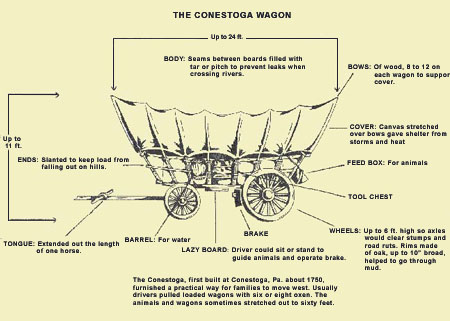
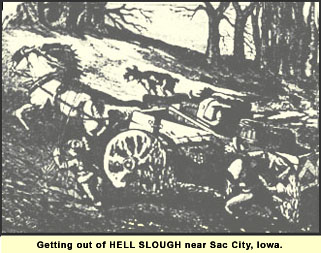 .
At times a crusty surface makes a flood plain look dry. Even the most
experienced teamsters can be tricked by the prairie.
.
At times a crusty surface makes a flood plain look dry. Even the most
experienced teamsters can be tricked by the prairie. 